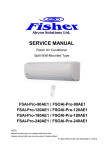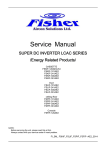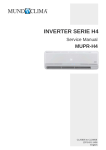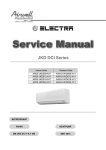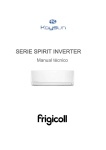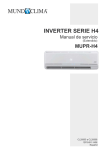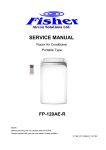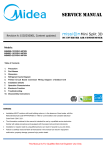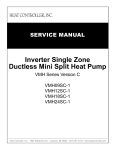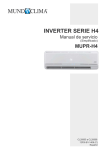Download SERVICE MANUAL
Transcript
SERVICE MANUAL Room Air Conditioner Split Wall-Mounted Type FSAI-SU-90AE2 / FSOAI-SU-90AE2 FSAI-SU-120AE2 / FSOAI-SU-120AE2 NOTE: Before servicing the unit, please read this at first. Always contact with your service center if meet problem. FI_SM_FSAI-SU-90-120AE2_150903 CONTENTS 1. Precaution .............................................................................................................................................. 3 1.1 Safety Precaution .......................................................................................................................... 3 1.2 Warning ......................................................................................................................................... 3 2. Function ................................................................................................................................................. 7 3. Dimension .............................................................................................................................................. 8 3.1 Indoor Unit ..................................................................................................................................... 8 3.2 Outdoor Unit ................................................................................................................................ 10 4. Diagrams ............................................................................................................................................... 11 4.1 Refrigerant Cycle Diagram...........................................................................................................11 4.2 Wiring Diagram ........................................................................................................................... 12 5 Installation Details .................................................................................................................................12 5.1 Wrench torque sheet for installation ......................................................................................... 144 5.2 Connecting the cables ................................................................................................................ 14 5.3 Pipe length and the elevation ..................................................................................................... 15 5.4 Installation for the first time ......................................................................................................... 16 5.5 Adding the refrigerant after running the system for many years ................................................ 20 5.6 Re-installation while the indoor unit need to be repaired ........................................................... 21 5.7 Re-installation while the outdoor unit need to be repaired ......................................................... 23 6. Operation Characteristics.....................................................................................................................26 7. Electronic function................................................................................................................................27 7.1 Abbreviation ................................................................................................................................ 27 7.2 Display function ........................................................................................................................... 27 7.3 Main Protection ........................................................................................................................... 28 7.4 Operation Modes and Functions................................................................................................. 30 8. Troubleshooting ....................................................................................................................................39 1. Precaution 1.1 Safety Precaution To prevent injury to the user or other people and property damage, the following instructions must be followed. Incorrect operation due to ignoring instruction will cause harm or damage. Before service the unit, be sure to read this service manual at first. 1.2 Warning Installation Do not use a defective or underrated circuit breaker. Use this appliance on a dedicated circuit. There is risk of fire or electric shock. For electrical work, contact the dealer, seller, a qualified electrician, or an authorized service center. Do not disassemble or repair the product, there is risk of fire or electric shock. Always ground the product. There is risk of fire or electric shock. Install the panel and the cover of control box securely. There is risk of fire of electric shock. Always install a dedicated circuit and breaker. Improper wiring or installation may cause fore or electric shock. Use the correctly rated breaker of fuse. There is risk of fire or electric shock. Do not modify or extend the power cable. There is risk of fire or electric shock. Do not install, remove, or reinstall the unit by yourself (customer). There is risk of fire, electric shock, explosion, or injury. Be caution when unpacking and installing the product. Sharp edges could cause injury, be especially careful of the case edges and the fins on the condenser and evaporator. 3 For installation, always contact the dealer or an authorized service center. Do not install the product on a defective installation stand. Be sure the installation area does not deteriorate with age. If the base collapses, the air conditioner could fall with it, causing property damage, product failure, and personal injury. Do not let the air conditioner run for a long time when the humidity is very high and a door or a window is left open. Take care to ensure that power cable could not be pulled out or damaged during operation. There is risk of fire or electric shock. Do not place anything on the power cable. There is risk of fire or electric shock. Do not plug or unplug the power supply plug during operation. There is risk of fire or electric shock. Do not touch (operation) the product with wet hands. Do not place a heater or other appliance near the power cable. There is risk of fire and electric shock. Do not allow water to run into electrical parts. It may cause fire, failure of the product, or electric shock. Do not store or use flammable gas or combustible near the product. There is risk of fire or failure of product. Do not use the product in a tightly closed space for a long time. Oxygen deficiency could occur. When flammable gas leaks, turn off the gas and open a window for ventilation before turn the product on. If strange sounds or smoke comes from product, turn the breaker off or disconnect the power supply cable. There is risk of electric shock or fire. Stop operation and close the window in storm or hurricane. If possible, remove the product from the window before the hurricane arrives. There is risk of property damage, failure of product, or electric shock. 4 Do not open the inlet grill of the product during operation. (Do not touch the electrostatic filter, if the unit is so equipped.) There is risk of physical injury, electric shock, or product failure. When the product is soaked, contact an authorized service center. There is risk of fire or electric shock. Be caution that water could not enter the product. There is risk of fire, electric shock, or product damage. Ventilate the product from time to time when operating it together with a stove etc. There is risk of fire or electric shock. Turn the main power off when cleaning or maintaining the product. There is risk of electric shock. When the product is not be used for a long time, disconnect the power supply plug or turn off the breaker. There is risk of product damage or failure, or unintended operation. Take care to ensure that nobody could step on or fall onto the outdoor unit. This could result in personal injury and product damage. CAUTION Always check for gas (refrigerant) leakage after installation or repair of product. Low refrigerant levels may cause failure of product. Install the drain hose to ensure that water is drained away properly. A bad connection may cause water leakage. Keep level even when installing the product. It can avoid vibration of water leakage. Do not install the product where the noise or hot air from the outdoor unit could damage the neighborhoods. It may cause a problem for your neighbors. Use two or more people to lift and transport the product. Do not install the product where it will be exposed to sea wind (salt spray) directly. It may cause corrosion on the product. Corrosion, particularly on the condenser and evaporator fins, could cause product malfunction or inefficient operation. 5 Operational Do not expose the skin directly to cool air for long time. (Do not sit in the draft). Do not use the product for special purposes, such as preserving foods, works of art etc. It is a consumer air conditioner, not a precision refrigerant system. There is risk of damage or loss of property. Do not block the inlet or outlet of air flow. Use a soft cloth to clean. Do not use harsh detergents, solvents, etc. There is risk of fire, electric shock, or damage to the plastic parts of the product. Do not touch the metal parts of the product when removing the air filter. They are very sharp. Do not step on or put anything on the product. (outdoor units) Always insert the filter securely. Clean the filter every two weeks or more often if necessary. A dirty filter reduces the efficiency of the air conditioner and could cause product malfunction or damage. Do not insert hands or other objects through air inlet or outlet while the product is operated. Do not drink the water drained from the product. Use a firm stool or ladder when cleaning or maintaining the product. Be careful and avoid personal injury. Replace the all batteries in the remote control with new ones of the same type. Do not mix old and new batteries or different types of batteries. There is risk of fire or explosion. Do not recharge or disassemble the batteries. Do not dispose of batteries in a fire. They may burn of explode. If the liquid from the batteries gets onto your skin or clothes, wash it well with clean water. Do not use the remote of the batteries have leaked. 6 2. Function Model Names of Indoor/Outdoor Units Capacity Indoor units Outdoor units 9k FSAI-SU-90AE2 FSOAI-SU-90AE2 12k FSAI-SU-120AE2 FSOAI-SU-120AE2 DC Inverter 7 3. Dimension 3.1 Indoor Unit H D W Model W D H FSAI-SU-90AE2 715 188 250 FSAI-SU-120AE2 800 188 275 8 Model L(mm) R(mm) H(mm) FSAI-SU-90AE2 85 88 45 Dimension of installation hole(mm) ¢65 FSAI-SU-120AE2 100 95 9 45 3.2 Outdoor Unit More than 30cm More than 60cm (Service space) More than 30cm Fe n ob ce o sta r cle s More than 60cm More than 200cm Model W D H W1 A B FSOAI-SU-90AE2 780 250 540 843 549 276 FSOAI-SU-120AE2 780 250 540 843 549 276 10 4. Diagrams 4.1 Refrigerant Cycle Diagram INDOOR OUTDOOR CHECK VALVE (Heating Model only) LIQUID SIDE 2-WAY VALVE T3 Condenser temp. sensor CAPILIARY TUBE HEAT EXCHANGE (EVAPORATOR) HEAT EXCHANGE (CONDENSER) T4 Ambient temp. sensor T1 Room temp. sensor T2 Evaporator temp. sensor GAS SIDE 4-WAY VALVE 3-WAY VALVE Accumulator Compressor T5 Discharge temp. sensor COOLING HEATING 11 4.2 Wiring Diagram Indoor unit FSAI-SU-90AE2 , FSAI-SU-120AE2 Outdoor unit FSOAI-SU-90AE2 12 Outdoor unit FSOAI-SU-120AE2 13 5 Installation Details 5.1 Wrench torque sheet for installation Outside diameter Torque Additional tightening torque mm inch N.cm N.cm Ф6.35 1/4 1500(153kgf.cm) 1600(163kgf.cm) Ф9.52 3/8 2500(255kgf.cm) 2600(265kgf.cm) 5.2 Connecting the cables The power cord of connect should be selected according to the following specifications sheet. Rated capacity kBTU/h Nominal cross-sectional area (mm²) 9k 2,5 12k 2,5 The cable size and the current of the fuse or switch are determined by the maximum current indicated on the nameplate which located on the side panel of the unit. Please refer to the nameplate before selecting the cable, fuse and switch. 14 5.3 Pipe length and the elevation The pipe length and refrigerant amount: Pipe size Model FSAI-SU-90AE2 / FSOAI-SU-90AE2 Gas Liquid 3/8’’ (Ф9.52) 1/4’’ (Ф6.35) FSAI-SU-120AE2 / FSOAI-SU-120AE2 Standard length (m) Max. Elevation B (m) Max. Length A (m) Additional refrigerant (g/m) 5 10 25 20 5 10 25 20 Caution: The capacity test is based on the standard length and the maximum permissive length is based on the system reliability. 15 5.4 Installation for the first time Air and moisture in the refrigerant system have undesirable effects as below: ● Pressure in the system rises. ● Operating current rises. ● Cooling or heating efficiency drops. ● Moisture in the refrigerant circuit may freeze and block capillary tubing. ● Water may lead to corrosion of parts in the refrigerant system. Therefore, the indoor units and the pipes between indoor and outdoor units must be leak tested and evacuated to remove gas and moisture from the system. Gas leak check (Soap water method): Apply soap water or a liquid neutral detergent on the indoor unit connections or outdoor unit connections by a soft brush to check for leakage of the connecting points of the piping. If bubbles come out, the pipes have leakage. 1. Air purging with vacuum pump (Indoor unit) (Outdoor unit) (Liquid side) Two-way valve Close (Gas side) Three-way valve Manifold valve Compound meter Pressure gauge -0.1MPa Lo Handle Lo Charge hose Hi Handle Hi Charge hose Vacuum pump Vacuum pump 16 Close 1) Completely tighten the flare nuts of the indoor and outdoor units, confirm that both the 2-way and 3-way valves are set to the closed position. 2) Connect the charge hose with the push pin of handle lo to the 3-way valves gas service port.. 3) Connect the charge hose of handle hi connection to the vacuum pump. 4) Fully open the handle Lo of the manifold valve. 5) Operate the vacuum pump to evacuate. 6) Make evacuation for 30 minutes and check whether the compound meter indicates -0.1Mpa. If the meter does not indicate -0.1Mpa after pumping 30 minutes, it should be pumped 20 minutes more. If the pressure can’t achieve -0.1Mpa after pumping 50 minutes, please check if there are some leakage points. Fully close the handle Lo valve of the manifold valve and stop the operation of the vacuum pump. Confirm that the gauge needle does not move (approximately 5 minutes after turning off the vacuum pump). 7) Turn the flare nut of the 3-way valves about 45° counterclockwise for 6 or 7seconds after the gas coming out, then tighten the flare nut again. Make sure the pressure display in the pressure indicator is a little higher than the atmosphere pressure. Then remove the charge hose from the 3 way valve. 8) Fully open the 2 way valve and 3 way valve and securely tighten the cap of the 3 way valve. 17 2. Air purging by refrigerant Procedure: 1). Confirm that both the 2-way and 3-way valves are set to the closed position. 2). Connect the charge set and a charging cylinder to the service port of the 3-way valve. 3). Air purging. Open the valves on the charging cylinder and the charge set. Purge the air by loosening the flare nut on the 2-way valve approximately 45’ for 3 seconds then closing it for 1 minute; repeat 3 times. After purging the air, use a torque wrench to tighten the flare nut on the 2-way valve. 4). Check the gas leakage. Check the flare connections for gas leakage. 5). Discharge the refrigerant. Close the valve on the charging cylinder and discharge the refrigerant by loosening the flare nut on the 2-way valve approximately 45’ until the gauge indicates 0.3 to 0.5 Mpa. 6). Disconnect the charge set and the charging cylinder, and set the 2-way and 3-way valves to the open position. Be sure to use a hexagonal wrench to operate the valve stems. 7). Mount the valve stems nuts and the service port cap. 18 Be sure to use a torque wrench to tighten the service port cap to a torque 18N·m. Be sure to check the gas leakage. 3. Adding the refrigerant if the pipe length >5m Electronic scale Procedure: 1). Connect the charge hose to the charging cylinder, open the 2-way valve and the 3-way valve. Connect the charge hose which you disconnected from the vacuum pump to the valve at the bottom of the cylinder. If the refrigerant is R410A, make the cylinder bottom up to ensure the liquid charge. 2). Purge the air from the charge hose. Open the valve at the bottom of the cylinder and press the check valve on the charge set to purge the air (be careful of the liquid refrigerant). 3) Put the charging cylinder onto the electronic scale and record the weight. 4) Operate the air conditioner at the cooling mode. 5) Open the valves (Low side) on the charge set and charge the system with liquid refrigerant. 6).When the electronic scale displays the proper weight (refer to the table), disconnect the charge hose from the 3-way valve’s service port immediately and turn off the air conditioner before disconnecting the hose. 7). Mount the valve stem caps and the service port Use torque wrench to tighten the service port cap to a torque of 18N.m. 19 Be sure to check for gas leakage. 5.5 Adding the refrigerant after running the system for many years Electronic scale Procedure: 1). Connect the charge hose to the 3-way service port, open the 2-way valve and the 3-way valve. Connect the charge hose to the valve at the bottom of the cylinder. If the refrigerant is R410A, make the cylinder bottom up to ensure liquid charge. 2). Purge the air from the charge hose. Open the valve at the bottom of the cylinder and press the check valve on the charge set to purge the air (be careful of the liquid refrigerant). 3) Put the charging cylinder onto the electronic scale and record the weight. 4) Operate the air conditioner at the cooling mode. 5) Open the valves (Low side) on the charge set and charge the system with liquid refrigerant. 6).When the electronic scale displays the proper weight (refer to the gauge and the pressure of the low side), disconnect the charge hose from the 3-way valve’s service port immediately and turn off the air conditioner before disconnecting the hose. 7). Mount the valve stem caps and the service port Use torque wrench to tighten the service port cap to a torque of 18N.m. 20 Be sure to check for gas leakage. 5.6 Re-installation while the indoor unit need to be repaired 1. Collecting the refrigerant into the outdoor unit Procedure 1). Confirm that both the 2-way and 3-way valves are set to the opened position Remove the valve stem caps and confirm that the valve stems are in the opened position. Be sure to use a hexagonal wrench to operate the valve stems. 2). Connect the charge hose with the push pin of handle lo to the 3-way valves gas service port. 3). Air purging of the charge hose. Open the handle Lo valve of the manifold valve slightly to purge air from the charge hose for 5 seconds and then close it quickly. 4). Set the 2-way valve to the close position. 5). Operate the air conditioner at the cooling cycle and stop it when the gauge indicates 0.1MPa. 6). Set the 3-way valve to the closed position immediately Do this quickly so that the gauge ends up indicating 0.3 to 0.5Mpa. Disconnect the charge set, and tighten the 2-way and 3-way valve’s stem nuts. Use a torque wrench to tighten the 3-way valves service port cap to a torque of 18N.m. 21 Be sure to check for gas leakage. 2. Air purging by the refrigerant Procedure: 1). Confirm that both the 2-way and 3-way valves are set to the closed position. 2). Connect the charge set and a charging cylinder to the service port of the 3-way valve Leave the valve on the charging cylinder closed. 3). Air purging. Open the valves on the charging cylinder and the charge set. Purge the air by loosening the flare nut on the 2-way valve approximately 45’ for 3 seconds then closing it for 1 minute; repeat 3 times. After purging the air, use a torque wrench to tighten the flare nut on the 2-way valve. 4). Check the gas leakage Check the flare connections for gas leakage. 5). Discharge the refrigerant. Close the valve on the charging cylinder and discharge the refrigerant by loosening the flare nut on the 2-way valve approximately 45’ until the gauge indicates 0.3 to 0.5 Mpa. 6). Disconnect the charge set and the charging cylinder, and set the 2-way and 3-way valves to the open position 22 Be sure to use a hexagonal wrench to operate the valve stems. 7). Mount the valve stems nuts and the service port cap Be sure to use a torque wrench to tighten the service port cap to a torque 18N.m. Be sure to check the gas leakage. 5.7 Re-installation while the outdoor unit need to be repaired 1. Evacuation for the whole system Procedure: 1). Confirm that both the 2-way and 3-way valves are set to the opened position. 2). Connect the vacuum pump to 3-way valve’s service port. 3). Evacuation for approximately one hour. Confirm that the compound meter indicates -0.1Mpa. 4). Close the valve (Low side) on the charge set, turn off the vacuum pump, and confirm that the gauge needle does not move (approximately 5 minutes after turning off the vacuum pump). 5). Disconnect the charge hose from the vacuum pump. 23 2. Refrigerant charging Electronic scale Procedure: 1). Connect the charge hose to the charging cylinder, open the 2-way valve and the 3-way valve Connect the charge hose which you disconnected from the vacuum pump to the valve at the bottom of the cylinder. If the refrigerant is R410A, make the cylinder bottom up to ensure liquid charge. 2). Purge the air from the charge hose Open the valve at the bottom of the cylinder and press the check valve on the charge set to purge the air (be careful of the liquid refrigerant). 3) Put the charging cylinder onto the electronic scale and record the weight. 4). Open the valves (Low side) on the charge set and charge the system with liquid refrigerant If the system cannot be charge with the specified amount of refrigerant, or can be charged with a little at a time (approximately 150g each time) , operating the air conditioner in the cooling cycle; however, one time is not sufficient, wait approximately 1 minute and then repeat the procedure. 5).When the electronic scale displays the proper weight, disconnect the charge hose from the 3-way valve’s service port immediately If the system has been charged with liquid refrigerant while operating the air conditioner, turn off the air conditioner before disconnecting the hose. 6). Mounted the valve stem caps and the service port 24 Use torque wrench to tighten the service port cap to a torque of 18N.m. Be sure to check for gas leakage 25 6. Operation Characteristics Temperature Cooling operation Heating operation Drying operation Room temperature 17°C~ 32°C 0°C~≤30°C 10°C~32°C Outdoor temperature -15°C~50°C -15°C~30°C 0°C~50°C Mode CAUTION: 1. If the air conditioner is used beyond the above conditions, certain safety protection features may come into operation and cause the unit to operate abnormally. 2. The room relative humidity should be less than 80%. If the air conditioner operates beyond this figure, the surface of the air conditioner may attract condensation. Please set the vertical air flow louver to its maximum angle (vertically to the floor), and set HIGH fan mode. 3. The optimum performance will be achieved during this operating temperature zone. 26 7. Electronic function 7.1 Abbreviation T1: Indoor room temperature T2: Coil temperature of evaporator T3: Coil temperature of condenser T4: Outdoor ambient temperature T5: Compressor discharge temperature 7.2 Display function 7.2.1 Icon explanation on indoor display board. fresh defrost It has no function on this unit DEFROST indication lamp(For cooling & heating models only): Lights up when the air conditioner starts defrosting automatically or when the warm air control feature is activated in heating operation. run timer OPERATION indication lamp:This lamp illuminates when the air conditioner is in operation. TIMER indication lamp:Lights up during Timer operation. Temperature indicator:Displays the temperature settings when the air conditioner is operational. Displays the malfunction code. 27 7.3 Main Protection 7.3.1 Time delay at restart for compressor Less than 1 minute delay for the 1st time start-up and 3 minutes delay for others. 7.3.2 Temperature protection of compressor top The unit will stop working when the compressor top temp. protector cut off, and will restart after the compressor top temp. protector restart. 7.3.3 Temperature protection of compressor discharge Compressor discharge temp. T5>115℃ for 5s, compressor stops. 7.3.4 Fan Speed is out of control When Indoor Fan Speed keeps too low (300RPM) for certain time, the unit will stop and the LED will display the failure 7.3.5 Inverter module protection The Inverter module has a protection function about current, voltage and temperature. If these protections happen, the corresponding code will display on indoor unit and the unit will stop working. 7.3.6 Indoor fan delayed open function When the unit starts up, the louver will be active immediately and the indoor fan will open 10s later. If the unit runs in heating mode, the indoor fan will be also controlled by anti-cold wind function. 7.3.7 Compressor preheating functions Preheating permitting condition: When T4(outdoor ambient temperature)<3°C, the preheating function will be activated. 7.3.8 Sensor protection at open circuit and breaking disconnection. When there’s only one temperature sensor in malfunction , the air conditioner will keep working but show the error code, in case of any emergency use. When there’s more than one temperature sensor in malfunction, the air conditioner will stop working 7.3.9 Refrigerant leakage detection This function is only active in cooling mode. It can better prevent the compressor being damaged by refrigerant leakage or compressor overload. Open condition: When compressor is active, the value of the Coil temperature of evaporator T2 has no change or very little change. 28 7.3.10 Zero crossing detection error protection If AC detects time interval is not correct, the unit will stop and the LED will display the failure. 29 7.4 Operation Modes and Functions 7.4.1 Fan mode (1) Outdoor fan and compressor stop. (2) Temperature setting function is disabled, and no setting temperature is displayed. (3) Indoor fan can be set to high/med/low/auto. (4) The louver operates same as in cooling mode. (5) Auto fan: T1 a b c d e 7.4.2 Cooling Mode 7.4.2.1 Compressor running rules When T1-Ts<-2℃, the compressor will stop, when T1—TS>-0.5℃,the compressor will be activated. When the AC run in mute mode, the compressor will run with low frequency. When the current is more than setting value, the current protection function will be activated, and the compressor will stop. 7.4.2.2 Outdoor fan running rules The outdoor unit will be run at different fan speed according to T4. For different outdoor units, the fan speeds are different T4 A+ A B C D E 30 7.4.2.3 Indoor fan running rules In cooling mode, indoor fan runs all the time and the speed can be selected as high, medium, low and auto. When the setting temp. is reached,if the compressor stop running,indoor fan motor will run in Minimum speed or setting speed. The indoor fan is controlled as below: Setting fan T1-Td ℃(°F) speed Actual fan speed H+(H+=H+G) H(=H) A B C H H-(H-=H-G) M+(M+=M+Z) M(M=M) D E F M M-(M-=M-Z) L+(L+=L+D) L(L=L) G H I L L-(L-=L-D) The auto fan acts as below rules: T1 a b c d e 7.4.2.4 Condenser temperature protection T3 Off Decrease Hold Resume When condenser temperature temp. is more than setting value, the compressor will stop. 7.4.2.5 Evaporator temperature protection When Evaporator temperature temp.is less than setting value, the compressor will stop. 31 7.4.3 Heating Mode 7.4.3.1 Compressor running rules When T1-Ts>ΔT, the compressor will stop, when T1-TS<ΔT-1.5 the compressor will be on. ΔT is the programmed parameter of temperature compensation. When the current is more than setting value,the current protection function will be activated and the compressor will stop. 7.4.3.2 Outdoor fan running rules The outdoor unit will be run at different fan speed according to T4. For different outdoor units,the fan speeds are different T4 E D C B A A+ 7.4.3.3 Indoor fan running rules When the compressor is on, the indoor fan can be set to high/med/low/auto. When indoor unit coil temp. is low, the anti-cold air function will start and indoor fan motor will run at low speed, the speed can’t be changed ,when the temp. is lower than setting value, the indoor fan motor will stop. When the indoor temp reaches the setting temp., the compressor will stop, the indoor fan motor will run at the minimum speed or setting speed.(The anti-cold air function is valid). The indoor fan is controlled as below: 32 Setting fan T1-Td+ΔT℃ speed Actual fan speed H-(H-=H-G) H H(=H) H+(H+=H+G) M-(M-=M-Z) M M(M=M) M+(M+=M+Z) L-(L-=L-D) L L(L=L) L+(L+=L+D) - Auto fan action in heating mode: T 1 -T d + ¦ ¤ T 7.4.3.4 Defrosting mode AC will enter the defrosting mode according to the value of temp. of T3 and the value range of temp. change of T3 and also the compressor running time. During the defrosting mode, the compressor keep running, indoor and outdoor motor will stop, defrost lamp of the indoor unit will be lighted “ .” Will be displayed. 7.4.3.5 Evaporator coil temperature protection Off Decrease Hold Resume When evaporator temperature temp. is more than the setting protection value, the compressor will 33 stop. 7.4.4 Auto-mode This mode can be chosen with remote controller and the setting temperature can be changed between 17~30℃. In auto mode, the machine will choose cooling, heating or fan-only mode according to ΔT (ΔT =T1-Ts). T1-Ts Cooling Fan only Heating* Indoor fan will run at auto fan of the relevant mode. The louver operates same as in relevant mode. If the machine switches mode between heating and cooling, the compressor will keep stopping for certain time and then choose mode according to T1-Ts. If the setting temperature is modified, the machine will choose running function again. 7.4.5 Drying mode 7.4.5.1 Indoor fan speed is fixed at breeze and can’t be changed. The louver angle is the same as in cooling mode. 7.4.5.2 Low indoor room temperature protection In drying mode, if room temperature is lower than 10℃, the compressor will stop and not resume until room temperature exceeds 12℃. 7.4.5.3 Evaporator anti-freezing protection, condenser high temperature protection and outdoor unit frequency limit are active and the same as that in cooling mode. 34 7.4.5.4 The outdoor fan operates the same as in cooling mode. 7.4.6 Forced operation function 7.4.6.1 Enter forced operation function: When the machine is off, pressing the touch button will carry the machine to forced auto mode. If pressing the button once again within 5 seconds, the machine will turn into forced cooling mode. In forced auto, forced cooling or any other operation mode, pressing touch button will turn off the machine. 7.4.6.2 In forced operation mode, all general protections and remote control are available. 7.4.6.3 Operation rules: Forced cooling mode: The compressor runs at F2 frequency and indoor fan runs as breeze. After running for 30 minutes. the machine will turn to auto mode as 24℃ setting temperature. Forced auto mode: The action of forced auto mode is the same as normal auto mode with 24℃ setting temperature. 7.4.7 Auto-Restart function The indoor unit is equipped with auto-restart function, which is carried out through an auto-restart module. In case of a sudden power failure, the module memorizes the setting conditions before the power failure. The unit will resume the previous operation setting (not including swing function) automatically after 3 minutes when power returns. If the memorization condition is forced cooling mode, the unit will run in cooling mode for 30 minutes and turn to auto mode as 24℃ setting temp. If AC is off before power off and AC is required to start up now, the compressor will have 1 minute delay when power on. Other conditions, the compressor will have 3 minutes delay when restarts. 7.4.8 8℃ Heating(optional) When the compressor is running, the indoor fan motor will run without anti-cold air function. When the compressor is off, the indoor fan motor is off . 7.4.9 Frequency limitation protection 35 The PCB will detect the voltage of power supply and adjust the compressor running frequency to protect the system. 36 7.4.10 Point check function Press the LED button of the remote controller three times, and then press the AIR DIRECTION or SWING button three times in ten seconds, the buzzer will keep ring for two seconds. The air conditioner will enter into the information enquiry status. You can press the LED DISPLAY or AIR DIRECTION button to check the next or front item’s information. When the AC enter the “information enquiry” status, it will display the code name in 2 seconds, the details are as follows. Enquiry information Displaying code Meaning T1 T1 T1 temp. T2 T2 T2 temp. T3 T3 T3 temp. T4 T4 T4 temp. T2B Tb T2B temp. TP TP TP temp. TH TH TH temp. Targeted Frequency FT Targeted Frequency Actual Frequency Fr Actual Frequency Indoor fan speed IF Indoor fan speed Outdoor fan speed OF Outdoor fan speed EXV opening angle LA EXV opening angle Compressor continuous running time CT Compressor continuous running time Causes of compressor stop. Causes of compressor ST stop. Reserve A0 Reserve A1 Reserve 0 Reserve 1 Reserve 2 Reserve 3 Reserve 4 Reserve 5 Reserve 6 Reserve L Reserve A Reserve U Reserve T When the AC enter into the information enquiry status, it will display the code value in the next 25s, the details are as follows. 37 Enquiry Display value Meaning Remark T1,T2,T3,T4, -1F,-1E,-1d,-1c,- -25,-24,-23,-22,-21,-2 1. All the displaying temperature is actual T2B,TP,TH, 1b,-1A 0 Targeted -19—99 -19—99 2. All the temperature is °C no matter what Frequency, A0,A1,…A9 100,101,…109 kind of remote controller is used. Actual b0,b1,…b9 110,111,…119 3. T1,T2,T3,T4,T2B display range:-25~70, Frequency c0,c1,…c9 120,121,…129 TP display range:-20~130. d0,d1,…d9 130,131,…139 4. Frequency display range: 0~159HZ. E0,E1,…E9 140,141,…149 5. If the actual value exceeds the range, it F0,F1,…F9 150,151,…159 will display the maximum value or minimum information value. value. Indoor fan 0 OFF speed 1,2,3,4 Low speed, Medium /Outdoor fan speed, High speed, speed Turbo 14-FF For some big capacity motors. Actual fan For some small capacity motors, speed=Display value display value is from 14-FF(hexadecimal), turns to decimal the corresponding fan speed range is from value and then 200-2550RPM. multiply 10. The unit is RPM. EXV opening 0-FF angle Actual EXV opening value=Display value turns to decimal value and then multiply 2. Compressor 0-FF 0-255 minutes If the actual value exceeds the continuous range, it will display the maximum running time value or minimum value. Causes of 0-99 For the detailed Decimal display compressor meaning, please stop. consult with engineer Reserve 0-FF 38 8. Troubleshooting 8.1 Indoor Unit Error Display Operation lamp Timer lamp Display ☆ 1 time X E0 Indoor unit EEPROM parameter error ☆ 2 times X E1 Indoor / outdoor units communication error ☆ 3 times X E2 Zero-crossing signal detection error ☆ 4 times X E3 Indoor fan speed has been out of control ☆ 5 times X E4 ☆ 6 times X E5 ☆ 7 times X EC Refrigerant Leakage Detection ☆ 1 times O F0 Overload current protection ☆ 2 times O F1 ☆ 3 times O F2 ☆ 4 times O F3 ☆ 5 times O F4 Outdoor unit EEPROM parameter error ☆ 6 times O F5 Outdoor fan speed has been out of control ☆ 1 times ☆ P0 IPM malfunction or IGBT over-strong current protection ☆ 2 times ☆ P1 Over voltage or over low voltage protection ☆ 5 times ☆ P4 Inverter compressor drive error O(light) LED STATUS Open circuit or short circuit of indoor room temperature T1 sensor Open circuit or short circuit of evaporator coil temperature T2 sensor Open circuit or short circuit of outdoor ambient T4 temperature sensor Open circuit or short circuit of condenser coil temperature T3 sensor Open circuit or short circuit of compressor discharge T5 temperature sensor X(off) 39 ☆(flash) 8.2 Diagnosis and Solution 8.2.1 EEPROM parameter error diagnosis and solution(E0) EEPROM: a read-only memory whose contents can be erased and reprogrammed using a pulsed voltage. 40 8.2.2 Indoor unit and outdoor unit communication protection error diagnosis and solution (E1) 41 8.2.3 Zero crossing detection error diagnosis and solution(E2) 8.2.4 Fan speed has been out of control diagnosis and solution (E3/F5) 42 Index1: 1:Indoor or Outdoor DC Fan Motor(control chip is in fan motor) Power on and when the unit is in standby, measure the voltage of pin1-pin3, pin4-pin3 in fan motor connector. If the value of the voltage is not in the range showing in below table, the PCB must has problems and need to be replaced. DC motor voltage input and output NO. Color Signal Voltage 1 Red Vs/Vm 280V~380V 2 --- --- --- 3 Black GND 0V 4 White Vcc 14-17.5V 5 Yellow Vsp 0~5.6V 6 Blue FG 14-17.5V 2. Outdoor DC Fan Motor (control chip is in outdoor PCB) Power on ,and check if the fan can run normally, if the fan can run normally, the PCB must has problems and need to be replaced, If the fan can’t run normally, measure the resistance of each two pins. If the resistance is not equal to each other, the fan motor must have problems and need to be replaced, otherwise the PCB must has problems and need to be replaced. 3. Indoor AC Fan Motor Power on and set the unit running in fan mode at high fan speed. After running for 15 seconds, measure the voltage of pin1 and pin2. If the value of the voltage is less than 100V(208~240V power supply)or 50V(115V power supply), the PCB must has problems and need to be replaced. 43 8.2.5 Open circuit or short circuit of temperature sensor diagnosis and solution (E4/E5/F1/F2/F3) Check the connection between temperature sensor and PCB. No Correct the connection No Repalce the sensor Yes Measure the resistance value of the sensor Yes Replace indoor or outdoor main PCB 44 8.2.6 Refrigerant Leakage Detection diagnosis and solution (EC) 45 8.2.7 IPM malfunction or IGBT over-strong current protection diagnosis and solution(P0) 46 8.2.8 Over voltage or too low voltage protection diagnosis and solution(P1) 47 8.2.9 High temperature protection of compressor top diagnosis and solution(P2) 48 8.2.10 Inverter compressor drive error diagnosis and solution(P4) 49 Safety Electricity power is still kept in capacitors even the power supply is shut off. Do not forget to discharge the electricity power in capacitor. Electrolytic Capacitors (HIGH VOLTAGE! CAUTION!) Connect discharge resistance (approx.100Ω 40W) or soldering iron (plug) between +, - terminals of the electrolytic capacitor on the contrary side of the outdoor PCB. Note: The picture above is only for reference. The plug of your side may be different. Main parts check 1. Temperature sensor checking Disconnect the temperature sensor from PCB, measure the resistance value with a tester. 50 Temperature Sensors. Room temp.(T1) sensor, Indoor coil temp.(T2) sensor, Outdoor coil temp.(T3) sensor, Outdoor ambient temp.(T4) sensor, Compressor discharge temp.(T5) sensor. Measure the resistance value of each winding by using the multi-meter. Table 1: Some frequently-used R-T data for T1,T2,T3 and T4 sensor: Temperature (℃) 5 10 15 20 25 30 40 50 60 Resistance Value (KΩ) 26.9 20.7 16.1 12.6 10 8 5.2 3.5 2.4 Table 2: Some frequently-used R-T data for T5 sensor: Temperature (℃) 5 15 25 35 60 70 80 90 100 Resistance Value (KΩ) 141.6 88 56.1 36.6 13.8 9.7 6.9 5 3.7 Resistance value (KΩ) T5 T1,T2,T3,T4 Temperature (℃) 51 Spec. Code Model 2T0032301001 2T0032500828 FSAI-SU-90AE2/ FSOAI-SU-90AE2 FSAI-SU-120AE2 / FSOAI-SU-120AE2 Compressor ASK89D53UEZ ASK89D53UEZ Indoor fan motor RPG20E RPG20E WZDK36-38G-W WZDK36-38G-W (★) (★) Outdoor fan motor Note: The motor marked “★”means DC fan motor with control chip in the PCB 52 2. Compressor checking Measure the resistance value of each winding by using the tester. Position Resistance Value ASK89D53UEZ ASN108D22UEZ DA130M1C-31FZ DA150S1C-20FZ Blue - 2.45Ω 1.5Ω 1.77Ω 0.95Ω Black (20℃) (20℃) (20℃) (20℃) Blue - Red Red - Blue 3.IPM continuity check Turn off the power, let the large capacity electrolytic capacitors discharge completely, and dismount the IPM. Use a digital tester to measure the resistance between P and UVWN; UVW and N. Digital tester (+)Red (-)Black N P Normal resistance value U V ∞ (Several MΩ) W Digital tester (+)Red (-)Black U V Normal resistance value ∞ N (Several MΩ) W 4.Indoor AC Fan Motor Measure the resistance value of each winding by using the tester. 53 Position Resistance Value RPG20E Black - Red White - Black 430Ω±8% (20℃) 388Ω±8% (20℃) (Brand: Dayang) (Brand: Weiling) 370Ω±8% (20℃) 360Ω±8% (20℃) (Brand: Dayang) (Brand: Weiling) 54






















































